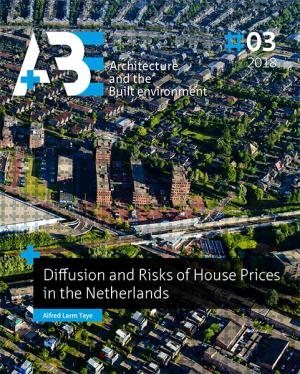Hosted by
Diffusion and Risks of House Prices in the Netherlands
Synopsis
The rate of home-ownership has increased significantly in many countries over the past decades. One motivating factor for this increase has been the creation of wealth through the accumulation of housing equity, which also forms the basic tenet of the asset-based welfare system.
In generating the home equity, house price developments play an important role. Generally, house prices show an increasing trend over long time period, however, there are short-term negative appreciations that may have inherent risks for the housing equity. Following the 2007-08 Global Financial Crisis (GFC), for example, the collapse of house prices has caused many recent home buyers to run into negative equity.
Some housing researchers and experts have suggested that a better understanding of the spatial diffusion mechanisms of house prices will aid resuscitating the housing market after the GFC. Others also advocated adopting insurance schemes to protect the home equity that yields the welfare benefits. Unfortunately, however, little research insight exists on the Dutch house price diffusion process, although there are empirical results for countries such as the UK, US and China, where the contexts differ from the Netherlands. Furthermore, the current existing home-value insurance scheme in the literature is found to be less efficient and eliminates only up to 50% of the house price risks.
This dissertation covers important aspects of house price diffusion and risks in the Netherlands. The aim is to better understand the diffusion mechanism and the risks of house prices, while it also contributes to the measurement of these housing risks. More specifically, there are three objectives: first, to discover the diffusion mechanism of house prices in the Netherlands and the pattern particularly from the capital Amsterdam; second, to examine the spatial distribution of the house price risk; and third, to investigate the efficiency of the index-based home-value insurance for reducing the house price risk in the Dutch context.
The diffusion mechanism relates to the so-called ripple or spillover effect, for which movements of house prices in one location temporarily or permanently spread over their influence to other regions. The risks analyses capture the probability of selling the residential property below the purchase price. The index-based home-value insurance scheme is concerned with the reduction of the house price risk, while its efficiency and loss coverage are analysed.
The contributions of the dissertation are specifically elaborated in five chapters. The chapters are self-contained, four of them having been published separately in international journals and the other being currently under review.
Chapter 2 is a literature study that presents the general trend and an overview of the risks in home-ownership. It particularly discusses the government mortgage guarantee and tax deduction, among other factors, which contribute to home-ownership in the Netherlands. Mortgage default risk and house price risk, which are the two important risks from the perspective of the home-owners are also discussed in the context of the Dutch market.
Chapter 3 investigates the house price diffusion mechanism between the twelve provinces in the Netherlands. The methodology adopts a new Bayesian graphical approach which enables a data-driven identification of the important regions where the diffusion may predominantly emerge. Using quarterly house price indexes, the findings suggest that house price diffusion exists in the Netherlands with a pattern varying over the period of time. Focusing specifically on the period prior to the 2007-2008 Global Financial Crisis (GFC), the house price diffusion predominantly originated from Noord-Holland.
House prices in Amsterdam — the capital and an important economic hub of the Netherlands, are more likely to diffuse to other parts of the country. Thus in Chapter 4, attention is paid to the house price diffusion pattern from the capital Amsterdam to the other Dutch regional housing markets. The Granger causality and cointegration techniques are used, while controlling for the important house price fundamentals. The results suggest a possible house price diffusion existing from Amsterdam to all regions in the Netherlands except for Zeeland. The strongest long-run impact of Amsterdam house price diffusion potentially occur in Utrecht.
As one of the largest and most dynamic in the Netherlands, the Amsterdam housing market is itself an interesting case study. One part of Chapter 5, therefore, deals with the diffusion pattern by studying the spatial interrelationships between house prices in Amsterdam. The other part of the chapter studies the house price risks. Using the Granger causality test, a general causal flow of house prices is observed from the central business districts to the peripherals. Simple statistics similarly reveal that house prices grow faster and are more risky in the central business districts than those on the peripherals of the city.
Chapter 6 is concerned with the efficiency and loss coverage of the index-based home-value insurance scheme. It proposes a modification of the index-based home-value insurances policy, which seeks to reduce the large idiosyncratic residual house price risks. The modification uses aggregate measures of the reference index. Using the hedonic and repeated sales indexes, the empirical analysis suggests the proposed modified scheme is highly efficient and may eliminate up to 70% of the residual risks.
In general, the dissertation adopts innovative empirical methodological approach that combines standard statistical analyses and more recent and complex econometric modelling techniques in the study of the diffusion and risks of house prices in the Netherlands. The application of the graphical approach to the study of diffusions particularly in Chapter 3, is the first of its kind in the context of the housing market.
Furthermore, this dissertation is among the first to entirely provide a comprehensive analysis and the much needed body of knowledge regarding the house price diffusion and risks for the highly regulated Dutch housing market. The results have important policy implications and applications for households, commercial investors and financial institutions in the Netherlands. The results may also generally apply and replicable in other countries and economies with similar housing market conditions.

